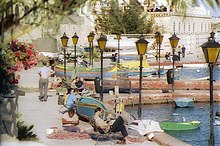St. Julian's, Malta
Saint Julian's
San Ġiljan Il-Qaliet | |
|---|---|
 St. Julian's skyline | |
| Motto(s): Għal kull bżonn (For every need) | |
 | |
| Coordinates: 35°55′7″N 14°29′24″E / 35.91861°N 14.49000°E | |
| Country | |
| Region | Central Region |
| District | Northern Harbour District |
| Borders | Gżira, Pembroke, San Ġwann, Sliema, Swieqi |
| Government | |
| • Mayor | Guido Dalli[1] (PN) |
| Area | |
| • Total | 1.6 km2 (0.6 sq mi) |
| Population (March 2014) | |
| • Total | 10,232 |
| • Density | 6,400/km2 (17,000/sq mi) |
| Demonym(s) | Ġiljaniż (m); Ġiljaniża (f), Ġiljaniżi (pl) |
| Time zone | UTC+1 (CET) |
| • Summer (DST) | UTC+2 (CEST) |
| Postal code | STJ |
| Dialing code | 356 |
| ISO 3166 code | MT-48 |
| Patron saint | St. Julian Our Lady of Mount Carmel |
| Day of festa | Last Sunday of August Last Sunday of July |
| Website | Official website |
Saint Julian's (Maltese: San Ġiljan) is a town in the Central Region of Malta. It is situated along the coast, north of the country's capital, Valletta. It is known for tourism-oriented businesses, such as hotels, restaurants and nightclubs which are centred mainly in an area known as Paceville.
Etymology
The town is named after its patron saint; Saint Julian who is widely known as Julian the Hospitaller and Julian the Poor whereby he is the patron Saint of hunters. Before the reform to the Calendar of Saints, the memorial to St Julian was on 27 January. Nowadays, it is celebrated on 12 February, although in Malta an additional feast, in the spirit of the many summer feasts around the island, is celebrated on the last Sunday of August.
About
The town is subdivided into informal districts which are Paceville, Ta' Ġiorni, Tal-Għoqod, St Andrew's, as well as the regions surrounding St George's Bay, Spinola Bay, Balluta Bay, and Il-Qaliet cliffs. St Julian's is popular, usually flowing with tourists, especially during the summer months. It is a well-sought after destination by the Maltese.
The population of Saint Julian's is 10,232 people as of March 2014.[2]
The Portomaso Business Tower, which is the tallest skyscraper in Malta, is located in St. Julian's.[3]
History
The Old Parish Church

The earliest documentary evidence of this church is of the pastoral visit of Bishop Tommaso Gargallo of 1601, which he says was built in 1580 and was dedicated to Saint Julian. In 1736, when Monsignor Alpheran de Bussan re-visited Saint Julian's, he noted that the locality was already known as Portus Sancti Juliani, meaning after the patron saint, evidence that the previous medieval name Qaliet Gnien il-Fieres was placed aside. In 1854, the 600 residents of Saint Julian's appealed to the church authority, in order to make it a parish. The chapter at Birkirkara protested strongly against such an application and consequently the application was denied; but it was granted at reapplication in 1891. Dun Guzepp Scerri became the first parish priest.
Up till the nineteenth and early twentieth century, St. Julians was a very peaceful coastal town known for its Latin architecture such as the Spinola Palace and beautiful greenery surrounding it. Moreover, Spinola bay was characterized by its fishermen and farmers dwelling the countryside.
Spinola Palace

Because of fear of attacks by the Muslims, the Northern Coastal area remained undeveloped until the diminished attacks after 1565. The building of Spinola Palace, coming as it does in 1688, is to be regarded as the stepping stone for the coastal reclamation of San Ġiljan. The palace, together with the surrounding gardens, was built by Fra Paola Raffaele Spinola for the public entertainment as stated in the inscription which one finds above the portico. The palace was enlarged in 1733 through the efforts of Fra Giovanni Battista Spinola, Bali of the order and successor to his uncle as rector and Curator of the abbazia. During the French occupation of these islands in 1798, St Julians was the first town in Malta to be conquered by French troops. In fact it was General Claude Henri Vaubois who led the French forces into Spinola bay. French troops were stationed in the palace and wrought havoc there. In fact it is thanks to them that the Order’s emblem atop the clock on the façade was defaced.
Zones in St. Julian's
- Balluta Bay
- Dragonara Point
- Garden Crescent
- Il-Qaliet
- Paceville
- Portomaso
- Spinola
- San Ġorġ
- St George's Park
- St Julian's Bay
- Ta' Giorni
- The Gardens
- The Village
- Villa Rosa
- Wied Ħarq Ħamiem
- Wied tal-Balluta
Notable events

- The St Julian's feast
- The Battle of Malta Poker Tournament
Sports
The football team that St. Julian's associates with is Melita F.C. Their greatest honour in Maltese football is their 4–0 victory over neighbours Sliema Wanderers in the Maltese Cup final in 1939. In recent years, Melita have also competed in the Maltese Premier League and presently compete in the 2nd tier of Maltese football. Another sport is extremely popular in the town – waterpolo. Since 1929 Neptunes W.P.S.C. has grown to be a dominant force in the Maltese leagues, whilst San Giljan Waterpolo Club, inconveniently placed 150 metres down the waterfront, has been a consistent title chaser and won the league during the summer league of 2015.
See also
References
- ^ "Councils Election". Electoral Commission Malta. Electoral Commission Malta. Retrieved 19 April 2015.
- ^ "Estimated Population by Locality 31st March, 2014". Government of Malta. 16 May 2014. Archived from the original on 21 June 2015.
{{cite web}}: Unknown parameter|deadurl=ignored (|url-status=suggested) (help) - ^ "Portomaso Business Tower". Emporis. Archived from the original on 22 February 2015.
External links
- St Julian's local council English language homepage of St Julian's local council


